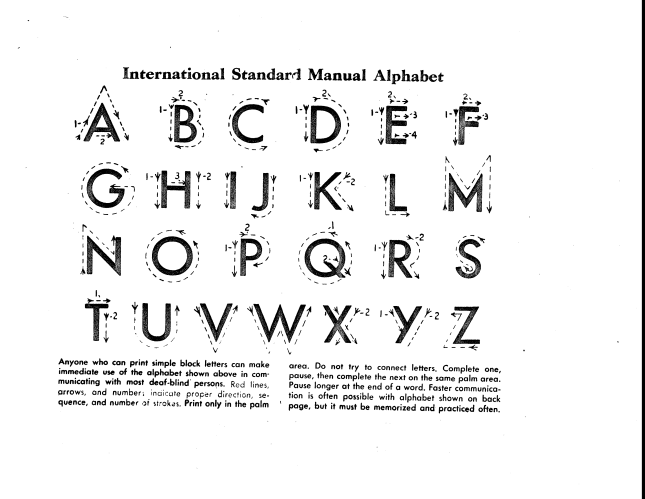Communication in the Deaf-Blind Community
Grade: Fourth
Subject: Community Building
Lesson Title: Communication in the Deaf-Blind Community
Materials:
William Terry Handout
Finger-spelling Handout
Pre-assessment of Student Knowledge:
Students were able to accurately complete a K-W-L Chart on deaf and blindness.
New York Learning Standards:
Languages Other Than English
Standard 1: Communication Skills
Students will be able to use a language other than English for communication.
Standard 2: Cultural Understanding
Students will develop cross-cultural skills and understandings.
Social Studies
Standard 2: World History
Students will use a variety of intellectual skills to demonstrate their understanding of major ideas, eras, themes, developments and turning points in world history and examine the broad sweep of history from a variety of perspectives.
Objectives:
Thinking Objective: Students will become aware of the different types of communication in the Deaf-Blind community.
Mastery Objective: Students will be able to communicate effectively using at least one common communication method.
Procedure
Introduction and Motivation:
Engaging Questions
Why is communication important?
Why do we communicate? Do we express your feelings Do we pass on important messages?
What are some ways to communicate? Examples: talking, telephone, text message, email, sign language, body language.
“Students, have you ever met anyone who had a hearing disability? What challenges would that person face? What about the person who had a visual disability like blindness? What challenges would that person face? Now think about a deaf and blind person. What extraordinary challenges would that person face? How would they do basic daily things?”
“Turn and talk to you partner about some ways that you would get ready for school in the morning if you were deaf-blind.”
Discuss Helen Keller: Born will an illness that left her deaf and blind She began to study, being a fast learner from then on. She quickly learned the finger-tip alphabet and shortly thereafter, to write. Helen had mastered Braille and learned how to use a typewriter by the age of 10. When she was 16, she could speak well enough to attend preparatory school and college. In 1904 she graduated from Radcliffe College with Anne Sullivan by her side interpreting lectures and class discussion to her. Helen Keller was a strong, intelligent woman. She overcame many obstacles in her own life to go on and improve the lives of others. She died June 1, 1968 in Westport, Connecticut and will go down in history as “America’s First Lady of Courage.”
Essential Questions
What are the challenges faced by a person who is deaf-blind?
What are some of the communication methods used by the deaf-blind community?
Direction Teaching:
“Students, today I am going to teach you about the different ways that the deaf-blind community is able to communicate. You will all become an expert in one of the most popular methods of communication.”
Teacher and students create deaf-blind communication web and discuss:
Braille- raised dots to touch
William Terry Touch Method- finger pads
Finger Spelling
Write directions on board:
Use forefinger to draw the clear shape of capital letters on the palm of the deaf-blind person’s hand
Use the whole palm for each letter. Make them large and clear
Please one letter over the top of the last
Do not write across the palm as you would on a sheet of paper
Pause slightly at the end of each word making sure that the person is able to follow
Draw letter left to right and top to bottom
Activities:
- Students will work in pairs to practice finger spelling.
- Students record short writing jots on the challenges that they faced using this form of communication.
Closure: Upon completion of activity, students will share their opinions and observations about the different methods used in class.
Assessment-Teacher will assess understanding during conference time and during the share. Ask follow up questions if students are not confident with their explanations. Students will be assessed for their activity participation, their participation as audience members and their working material.
Diversity: This lesson continues the work of opening a window into a past cultural experience through the use communication differences. Allowing students to communicate as a deaf-blind individual brings to life the understanding of their own challenges in respect to others.
Differentiation:
Using project-based and creative learning activities, students that struggle with comprehension are able to use their imaginations to show that they understand the content. This lesson also supports concreteness of the topic with the use of role-play.
Vocabulary Finger Spelling Words
Medium
APPLE
BABY
STOP
WAIT
MORNING
DINNER
MOTHER
TEACHER
SHOPPING
FRIEND
SHIRT
Very Hard
SUSPICIOUS
CONFIDENT
INTERSTING
EXCITED
LANGUAGE
CATEGORY
TROUBLE
TELEVISION
MACHINE
DISCIPLINE
EXPRESSION
WASHER
INTERNET
Phrases
GOOD MORNING
PHONE CALL
LET’S GO
THANK YOU
I NEED HELP
WHAT TIME
SEE YOU LATER
SCHOOL
HOMEWORK
DRINK
GREAT

